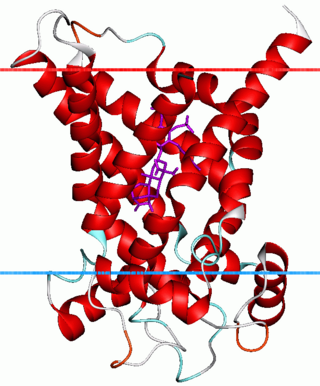Related Research Articles
The solute carrier (SLC) group of membrane transport proteins include over 400 members organized into 66 families. Most members of the SLC group are located in the cell membrane. The SLC gene nomenclature system was originally proposed by the HUGO Gene Nomenclature Committee (HGNC) and is the basis for the official HGNC names of the genes that encode these transporters. A more general transmembrane transporter classification can be found in TCDB database.

Mitochondrial carriers are proteins from solute carrier family 25 which transfer molecules across the membranes of the mitochondria. Mitochondrial carriers are also classified in the Transporter Classification Database. The Mitochondrial Carrier (MC) Superfamily has been expanded to include both the original Mitochondrial Carrier (MC) family and the Mitochondrial Inner/Outer Membrane Fusion (MMF) family.

Citrin, also known as solute carrier family 25, member 13 (citrin) or SLC25A13, is a protein which in humans is encoded by the SLC25A13 gene.

Phosphate carrier protein, mitochondrial is a protein that in humans is encoded by the SLC25A3 gene. The encoded protein is a transmembrane protein located in the mitochondrial inner membrane and catalyzes the transport of phosphate ions across it for the purpose of oxidative phosphorylation. There are two significant isoforms of this gene expressed in human cells, which differ slightly in structure and function. Mutations in this gene can cause mitochondrial phosphate carrier deficiency (MPCD), a fatal disorder of oxidative phosphorylation symptomized by lactic acidosis, neonatal hypotonia, hypertrophic cardiomyopathy, and death within the first year of life.

Peroxisomal membrane protein PMP34 is a protein that in humans is encoded by the SLC25A17 gene.

Mitochondrial 2-oxoglutarate/malate carrier protein is a protein that in humans is encoded by the SLC25A11 gene. Inactivating mutations in this gene predispose to metastasic paraganglioma.

Brain mitochondrial carrier protein 1 is a protein that in humans is encoded by the SLC25A14 gene.

Mitochondrial uncoupling protein 4 is a protein that in humans is encoded by the SLC25A27 gene.

Mitochondrial thiamine pyrophosphate carrier is a protein that in humans is encoded by the SLC25A19 gene.

The mitochondrial dicarboxylate carrier (DIC) is an integral membrane protein encoded by the SLC25A10 gene in humans that catalyzes the transport of dicarboxylates such as malonate, malate, and succinate across the inner mitochondrial membrane in exchange for phosphate, sulfate, and thiosulfate by a simultaneous antiport mechanism, thus supplying substrates for the Krebs cycle, gluconeogenesis, urea synthesis, fatty acid synthesis, and sulfur metabolism.

Calcium-binding mitochondrial carrier protein Aralar1 is a protein that in humans is encoded by the SLC25A12 gene. Aralar is an integral membrane protein located in the inner mitochondrial membrane. Its primary function as an antiporter is the transport of cytoplasmic glutamate with mitochondrial aspartate across the inner mitochondrial membrane, dependent on the binding of one calcium ion. Mutations in this gene cause early infantile epileptic encephalopathy 39 (EIEE39), symptomized by global hypomyelination of the central nervous system, refractory seizures, and neurodevelopmental impairment. This gene has connections to autism.

Solute carrier family 25 member 39 is a protein that in humans is encoded by the SLC25A39 gene. The protein has been shown to be necessary for the import of the major antioxidant glutathione into the mitochondria.

Tricarboxylate transport protein, mitochondrial, also known as tricarboxylate carrier protein and citrate transport protein (CTP), is a protein that in humans is encoded by the SLC25A1 gene. SLC25A1 belongs to the mitochondrial carrier gene family SLC25. High levels of the tricarboxylate transport protein are found in the liver, pancreas and kidney. Lower or no levels are present in the brain, heart, skeletal muscle, placenta and lung.

ADP/ATP translocase 4 (ANT4) is an enzyme that in humans is encoded by the SLC25A31 gene on chromosome 4. This enzyme inhibits apoptosis by catalyzing ADP/ATP exchange across the mitochondrial membranes and regulating membrane potential. In particular, ANT4 is essential to spermatogenesis, as it imports ATP into sperm mitochondria to support their development and survival. Outside this role, the SLC25AC31 gene has not been implicated in any human disease.

ADP/ATP translocase 3, also known as solute carrier family 25 member 6, is a protein that in humans is encoded by the SLC25A6 gene.

Solute carrier family 25, member 16 is a protein in humans that is encoded by the SLC25A16 gene.

ADP/ATP translocase 2 is a protein that in humans is encoded by the SLC25A5 gene on the X chromosome.

Calcium-binding mitochondrial carrier protein SCaMC-1 is a protein that in humans is encoded by the SLC25A24 gene.

Solute carrier family 25 member 22 is a protein that in humans is encoded by the SLC25A22 gene. This gene encodes a mitochondrial glutamate carrier. Mutations in this gene are associated with early infantile epileptic encephalopathy. Expression of this gene is increased in colorectal tumor cells.

Solute carrier family 25 member 46 is a protein that in humans is encoded by the SLC25A46 gene. This protein is a member of the SLC25 mitochondrial solute carrier family. It is a transmembrane protein located in the mitochondrial outer membrane involved in lipid transfer from the endoplasmic reticulum (ER) to mitochondria. Mutations in this gene result in neuropathy and optic atrophy.
References
- 1 2 3 "Solute carrier family 25, member 29" . Retrieved 2011-12-05.